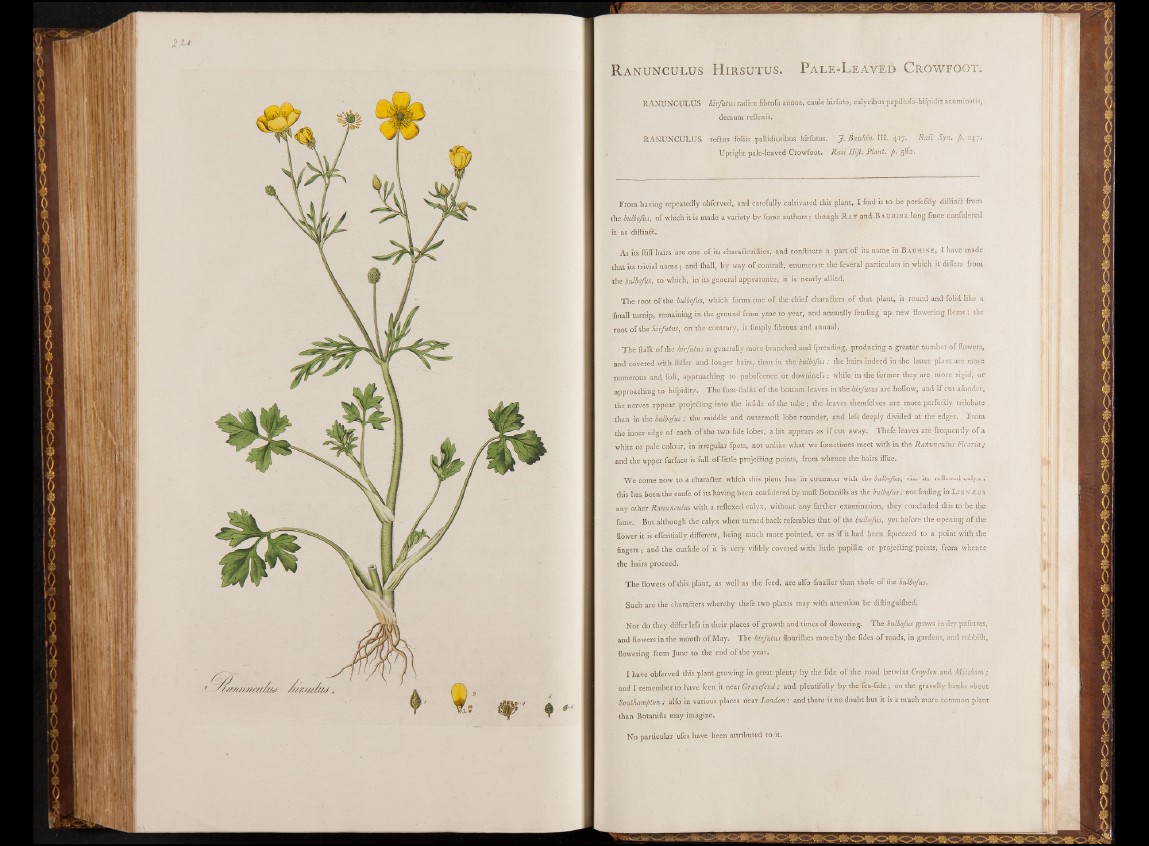
R a n u n c u l u s H i r s u t u s . P a l e - L e a v e d C r o w f o o t ;
RANÜNCÜLÜS hirfutus radice fibröfa aiinua; cäüle hirlutö, calycibus papillofo-hifpidis acufflinatis,
demum reflexis.
RANÜNCULUS redus föliis pallidioribus hirfutüs. jf. Bauhin. III. 417. R ail Syn. ft. 24 7;
Upright pale-leaved Cirowfoöt. R aii Hiß. Plant, ft. 5^2.
From having repeatedly obferved, and carefully cultivated this plant, I find it to be perfedly diftind frorti •
the bulbofus, of which it is made a variety by fome authors; though R ay and B auhine long fince confidered
it as difiind.
As its ftiff hairs are one o f its charaderiftics* and conftitute a part of its name in B auhine, I have made
that its trivial name; and (hall, by way of contrail, enumerate the feveral particulars in which it differs from
the bulbofus, to which, in its general appearance* it is nearly allied.
The root o f the bulbofus, which forms one of the chief charaders o f that plant, is round and folid like a
fmall turnip, remaining in the ground from year to year, and annually fending up new flowering ftems : the
root of the hirfutus, on the contrary, is fimply fibrous and annual.
The (talk of the hirfutus is generally more branched and fpreading, producing a greater number of flowers,
and covered with ftiffer and longer hairs, than in the bulbofus: the hairs indeed in the latter plant are more
numerous and foft, approaching to pubefcence or downinefs; while in the former they are more rigid, or
approaching to hifpidity. The foot-ftalks of the bottom leaves in the hirfutus are hollow, and if cut afunder,
the nerves appear projeding into the infide of the tube; the leaves themfelves are more perfedly trilobate
than in the bulbofus ; the middle and outermoft lobe rounder, and lefs deeply divided at the edges. From
the inner edge of each o f the two fide lobes, a bit appears as if cut away. Thefe leaves are frequently of a
white or pale colour, in irregular fpots, not unlike what we fometimes meet with in the Ranunculus Ficaria ;
and the upper furface is full of little projeding points, from whence the hairs iflue.
We come now to a charader which this plant has in common with the bulbofus, viz. its reflexed caly x:.
this has been the caufe of its having been confidered by moft Botanifts as the bulbofus; not finding in L inn je.us
any other Ranunculus with a reflexed calyx, without any farther examination, they concluded this to be the
fame. But although the calyx when turned back refembles that of the bulbofus., yet before the opening o f the
flower it is eflentially different, being much more pointed, or as if it had been fqueezed to a point with the
fingers; and the outfide of it is very vifibly covered with little papillae or projeding points, from whence
the hairs proceed.
The flowers of this plant, as well as the feed, are alfo fmaller than thofe of the bulbofus.
Such are the charaders whereby thefe two plants may with attention be diftinguifhed.
Nor do they differ lefs in their places of growth and times o f flowering. The bulbofus grows in dry paftures,
and flowers in the month of May. The hirfutus flourifhes more by the fides of roads, in gardens, and rubbifh,
flowering from June to the end of the year.
I have obferved this plant growing in great plenty by the fide of the road betwixt Croydon and Mitcham ;
and I remember to have feen it near Gravefend ; and plentifully by the fea-fide ; on the gravelly banks about
Southampton ; alfo in various places near London: and there is no doubt but it is a much more common plant
than Botanifts may imagine.
No particular ufes have been attributed to it.